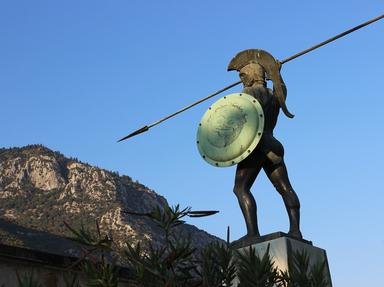Quiz Answer Key and Fun Facts
1. It is thought that Sparta was founded sometime around this year. Which?
2. The Dorians who founded the Greek city of Sparta known to us were said to be the descendants of this Greek hero of legend and myth. Who's the hero?
3. Located in the area known as Laconia, in the south central Peloponnese, Sparta was unusually blessed with good agricultural land.
4. The first four villages brought under control by the Spartans were these. Which are they?
5. Sparta's bitterest enemy within the Peloponnese was this ancient Greek city. Name it.
6. Sometime in the second half of the eighth century BC, Sparta become involved in a war which would eventually define it, much later, as the Sparta that people think of today-- a harsh militaristic society based on the primacy of the state. Who did Sparta go to war with around 743 BC?
7. Sometime around the end of the eighth century or first half of the seventh century BC, there arose a Spartan constitutional reformer by the name of Lycurgas. His reforms (the "Great Rhetra") were said to be based on reforms implemented earlier on this island. Which of these was it?
8. In Sparta, each Spartan citizen, as part of the Lycurgan reforms, was given a piece of land. What was this piece of land called?
9. Around the first and second quarter of the seventh century BC, the Spartans fought the Second Messenian War. From this conflict arose a poet who would become, in effect, the poet laureate for Sparta. Who was it?
10. In 669 BC, the Spartans suffered a serious setback at the Battle of Hysiae on the road between Tegea and Argos. Who defeated the Spartans that year?
11. Around 665, in response to the Spartan defeat at Hysiae, plague and internal political troubles, according to Huxley and George Smith, the Spartans created the festival of the Gymnopaedia. What is the Gymnopaedia?
12. While militarily superior to all of ancient Greece, the seventh and sixth century Spartans were culturally and economically backwards compared to other Greeks.
13. After the Messenians in the Second Messenian War were defeated c.650s BC, Spartans turned their expansionist attention southwest to this former Bronze Age home of Homer's King Nestor. What "city"?
14. A key component of the rise of Sparta was its mastery of this Greek military revolution, which occurred sometime around the middle of the seventh century BC. What was this military revolution?
15. Shortly after 600 BC, the Spartans sent a delegation to the Pythia at Delphi to learn their prospects for conquering Arcadia, a mountainous area to the north of Laconia. Despite the Pythia's response, they lost the "Battle of the Fetters" against this Arcadian city. What city?
16. Herodotus told the story, in his history, of Sparta and Orestes' Bones. Who was Orestes and what did his bones have to do with the rise of Sparta as a Greek power?
17. With the defeat of Tegea and the Archadians by the 560s, Spartan influence was on the rise throughout the Peloponnese. What was different about the way the Spartans handled the Tegeans and Arcadians after their defeat?
18. This Spartan ephor was said to be the main architect of Sparta's anti-tyrant policy that prevailed during the second half of the sixth century BC. He was also one of the Seven Sages of Greece. Who was he?
19. In 510 BC, the Spartan king Cleomenes I led a force to overthrow the tyrant Hippias in this growing city of importance located on the Attic peninsula. Name the city.
20. In 506 BC, Cleomenes gathered a group of Peloponnesian cities to intervene against the new Athenian democracy. What was the significance of the gathering of this group of cities?
Source: Author
Craterus
This quiz was reviewed by FunTrivia editor
bloomsby before going online.
Any errors found in FunTrivia content are routinely corrected through our feedback system.
